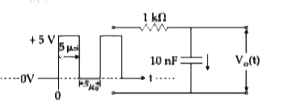In a negative feedback amplifier ,the gain without feedback is 100,feed back ratio is 1/25 and input voltage is 50 m V.Calculate.
i)gain with feedback
ii)feedback factor
iii)output voltage
iv)feedback voltage
v)new input voltage so that output voltage with feedbck the output voltage without feedback
To solve the problem step by step, we will calculate each of the requested values based on the given parameters.
Given:
- Gain without feedback, A=100
- Feedback ratio, β=125
- Input voltage, Vi=50mV=50×10−3V
Step 1: Calculate Gain with Feedback (AF)
The formula for the gain with feedback is given by:
AF=A1+βA
Substituting the values:
AF=1001+(125)×100
Calculating the denominator:
1+(125)×100=1+4=5
Thus,
AF=1005=20
Step 2: Calculate Feedback Factor (β)
The feedback factor is given directly as:
β=125
Step 3: Calculate Output Voltage (Vo)
The output voltage can be calculated using the formula:
Vo=AF×Vi
Substituting the values:
Vo=20×(50×10−3)=20×0.05=1V
Step 4: Calculate Feedback Voltage (Vf)
The feedback voltage is calculated using:
Vf=β×Vo
Substituting the values:
Vf=(125)×1=125V=0.04V=40mV
Step 5: Calculate New Input Voltage (V′i)
To find the new input voltage such that the output voltage with feedback equals the output voltage without feedback, we use:
V′i=Vi×(1+βA)
Substituting the values:
V′i=(50×10−3)×(1+4)=(50×10−3)×5
Calculating:
V′i=250×10−3=250mV
Summary of Results:
i) Gain with feedback, AF=20
ii) Feedback factor, β=125
iii) Output voltage, Vo=1V
iv) Feedback voltage, Vf=40mV
v) New input voltage, V′i=250mV
---
- Gain without feedback, A=100
- Feedback ratio, β=125
- Input voltage, Vi=50mV=50×10−3V
The formula for the gain with feedback is given by:
The feedback factor is given directly as:
The output voltage can be calculated using the formula:
The feedback voltage is calculated using:
To find the new input voltage such that the output voltage with feedback equals the output voltage without feedback, we use:
i) Gain with feedback, AF=20
Topper's Solved these Questions
- SEMICONDUCTOR DEVICESBOOK - AAKASH SERIESCHAPTER - SEMICONDUCTOR DEVICESEXERCISE - Exercise (Long answer questions)
6 Videos
- SEMICONDUCTOR DEVICESBOOK - AAKASH SERIESCHAPTER - SEMICONDUCTOR DEVICESEXERCISE - Exercise (Short answer questions)
27 Videos
- RAY OPTICSBOOK - AAKASH SERIESCHAPTER - RAY OPTICSEXERCISE - PROBLEMS ( LEVEL-II)
60 Videos
- UNITS AND MEASUREMENTBOOK - AAKASH SERIESCHAPTER - UNITS AND MEASUREMENTEXERCISE - PRACTICE EXERCISE
45 Videos
Similar Questions
Knowledge Check
Assertion : In an oscillator, the feedback is in the same phase which is called as positive feedback.
Reason: If the feedback voltage is in opposite phase, the gain is greater than one.AIf both assertion and reason are true and reason is the correct explanation of assertion.BIf both assertion and reason are true not but reason is not the correct explanation of assertion.CIf assertion is true but reason is falseDIf both assertion and reason are false.
Assertion (A):∧m(H⊕) and ∧m(cOH) ions are very much higher than those of other ions.
Reason (R):It is due to proton jump from one water molecule to another resulting in a more rapid transfer of positive charge form one region to another.
(a)If both (A) and (R) are correct, and (R) is the correct explanation of (A).
(b)If both (A) and (R) are correct, but (R) is not the correct explanation of (A).
(c)If (A) is correct, but (R) is incorrect.
(d)If (A) is incorrect, (R) is correct.
View SolutionIn a common emitter amplifier, the input and output voltage are out of phase by
View SolutionFor the given input voltage wavelength Vin(t) , the output voltage waveform (V0)(t) , across the capacitor is correctly depicted by :

View SolutionIn a step-down transformer input voltage is 200 volts and output voltage 5 volt. The ratio of nubmer of turns in it will be -
View SolutionWhen a triode is used as an amplifier the phase difference between the input signal voltage and the output is
View SolutionIn a common emitter amplifier, using output reisistance of 5000 ohm and input resistance fo 2000ohm, if the peak value of input signal voltage is 10mV and β=50, then the peak value of output voltage is
View SolutionThe peak voltage in the output of a half-wave diode rectifier fed with a sinusiodal signal without filter is 10V. The dc component of the output voltage is
View Solution
